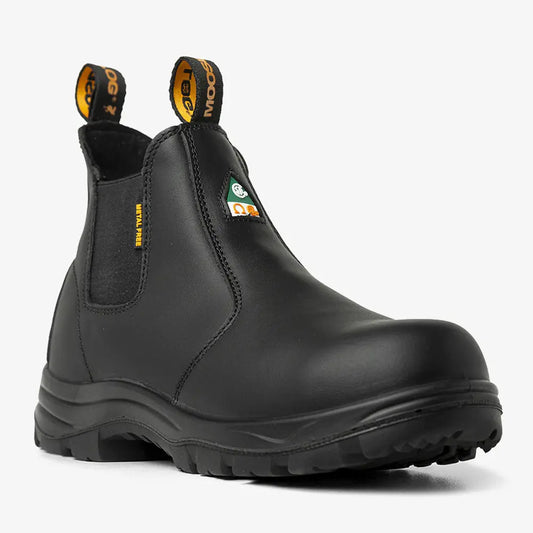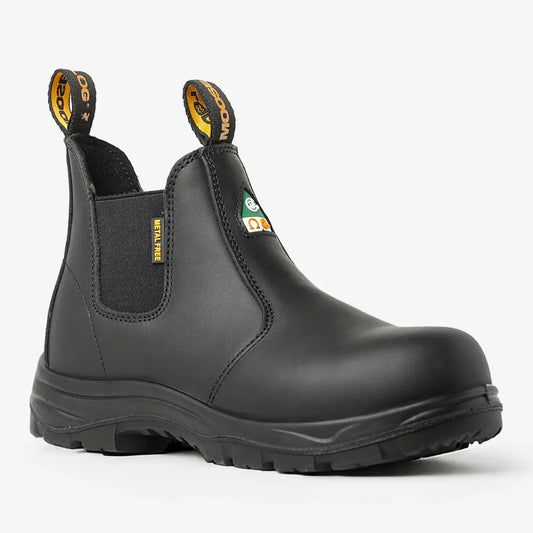
Lightweight CSA Approved Safety Shoes | What Makes Them Light?
Lightweight CSA approved safety shoes are becoming a common choice across warehouses, manufacturing plants, delivery operations, and service trades in Canada. Workers move through long shifts, lift heavy loads, and walk thousands of steps each day. Heavy footwear increases fatigue. Modern materials and updated construction methods reduce this load while meeting all CSA Z195 requirements for impact protection, puncture resistance, slip performance, and electrical protection.
This article explains the science behind lightweight CSA approved footwear. You will learn how toe caps, midsoles, outsoles, plates, fabrics, and construction methods produce a lighter shoe without reducing safety or durability.
Toe Cap Materials That Reduce Weight

The toe cap influences overall weight more than any other component. Many modern CSA approved safety shoes use composite materials because they provide full protection with a lower mass than steel.
Composite Toe Caps
Composite toe caps rely on materials like fiberglass, carbon fibre, and high-strength resins. These materials form a rigid shell that absorbs impact and spreads force. Composite materials do not conduct cold or heat. They do not set off metal detectors. They also allow designers to control thickness and shape with precision. Lower density gives composite toes high strength with less mass.
Composite toes meet the same CSA Z195 impact and compression requirements as steel toes. Their low weight reduces fatigue during long shifts.
Steel Toe Caps
Steel remains the heaviest option. It meets all required standards but increases total weight and transfers temperature more easily.
Penetration Plates and Lightweight Protection
CSA approved footwear may include a puncture-resistant component if it carries the green triangle mark. This is often a steel plate or a flexible composite plate.
Composite Puncture Plates
Composite plates use layers of fibres, resin, and advanced laminates. They block sharp objects while allowing the shoe to bend. They weigh far less than steel plates. Many lightweight CSA approved work shoes use composite plates to maintain mobility while passing puncture tests.
Steel Puncture Plates
Steel plates provide strong puncture resistance but increase weight and stiffness. They reduce flexibility through the entire midsole.
Midsole Construction and Lightweight Design
The midsole absorbs shock, supports the foot, and handles continuous movement. Modern midsole materials are among the biggest contributors to weight reduction.
Direct-Injected PU Midsoles
Polyurethane midsoles formed by direct injection bond cleanly to the upper and outsole. The process eliminates glue layers and extra materials. This reduces mass and increases durability. PU maintains cushioning and resilience through long shifts.
EVA Blends
EVA is lighter than PU and offers soft cushioning. Some designs mix EVA with rubber or denser foam to increase durability. EVA reduces total shoe mass and improves comfort underfoot.
Outsole Materials and Grip Without Extra Weight
Outsoles must pass CSA slip-testing requirements. The rubber compound influences traction and overall mass.
Light-Density Rubber
Light-density rubber reduces weight while maintaining grip on wet floors, dusty concrete, and metal surfaces. Designers adjust rubber composition to balance abrasion resistance and reduced mass.
TPU Outsoles
TPU outsoles provide high abrasion resistance with less weight than heavy rubber. Many lightweight CSA approved shoes use combined rubber and TPU formulas to balance traction and durability.
Upper Materials That Contribute to Low Weight
Upper materials influence breathability, comfort, and total mass.
Technical Mesh
Technical mesh blends synthetic fibers with abrasion-resistant overlays. This creates a breathable and flexible upper that reduces weight and limits heat buildup.
Microfibre and Synthetic Leather
Synthetic materials reduce mass and resist wear. They maintain shape, handle moisture well, and add structure without extra weight.
Engineered Overlays
Designers place TPU or rubber overlays only in high-wear areas. This reduces unnecessary bulk while keeping the shoe protective.
Construction Methods That Remove Extra Layers
The construction style affects how many layers the shoe needs and how much material is used.
Direct Injection
Direct injection bonds the midsole and outsole directly to the upper. This removes glue layers and reduces the number of components in each shoe.
One-Piece Uppers
A single-piece upper reduces seams and material overlap. Less overlap means lower mass and a smoother interior feel.
Welded Overlays
Welded overlays replace traditional stitched overlays. They maintain structural support without extra stitching or layered fabrics.
How Lightweight CSA Safety Shoes Perform on the Job
Lightweight CSA approved footwear benefits workers who walk and move often. Many jobs involve constant steps, ladder use, machine operation, and frequent bending. Less mass reduces fatigue across long shifts. Ergonomic research shows that footwear weight influences energy use and muscle load across the back, knees, and ankles. The Canadian Centre for Occupational Health and Safety provides guidance on how proper footwear supports job performance and reduces strain in active work environments
A lighter shoe helps maintain consistent movement throughout the shift. It protects under CSA Z195 requirements while reducing the energy needed for each step.
When Lightweight CSA Approved Safety Shoes Are a Good Choice
Lightweight CSA approved footwear works well in:
- warehouse operations
- manufacturing lines
- delivery work
- HVAC service
- electrical service
- landscaping
- property maintenance
- distribution centers
- retail stock rooms
Workers in these roles move more than they stand still. Reduced mass supports better endurance and comfort.
Heavy outdoor construction, demolition, rebar, and similar trades may require high-cut boots with thicker leather and deep lugs. Each jobsite has its own requirements. Workers should match footwear design to their hazard level and environment.
Where MooseLog Comes In

A cutaway view of the MooseLog Timber design. Each component contributes to reduced mass while meeting CSA Z195 requirements.
The SafeTread™ outsole uses a lighter rubber blend that maintains slip performance. The direct injected PU midsole removes extra layers and reduces overall bulk. The anti fatigue PU footbed supports the foot through continuous movement. The Dyna-Flex® composite plate provides puncture protection with low weight and full flexibility. The BigZone™ composite toe cap delivers certified impact protection with a lower density material. These elements work together to create a lighter CSA approved structure that supports long shifts and high-movement jobs.
A few months ago our team conducted a direct weight comparison across several popular CSA certified Chelsea-style safety boots sold in Canada. Each pair was weighed using the same scale and method. The Timber consistently came in lighter than the competitor models tested due to smarter material choices.
An example of one video can be found on our TikTok channel here.
Conclusion
Lightweight CSA approved safety shoes rely on composite toe caps, flexible plates, modern cushioning materials, and clean construction methods. These components reduce mass while still meeting all CSA Z195 protection requirements. Workers feel the difference in reduced fatigue and smoother movement during long shifts. Understanding the materials behind these designs helps workers choose the right option for their job and daily workload.
FAQ
What does CSA approved mean for safety shoes?
CSA approved safety shoes meet the requirements of CSA Z195. The standard defines impact protection, compression protection, puncture resistance, slip performance, and electrical protection. A certified lab tests each component before the shoe receives approval.
Are lightweight CSA approved safety shoes as safe as heavier ones?
If a shoe meets CSA Z195, it provides the required level of protection. The materials may differ, but the test standard remains the same. Toe caps, plates, soles, and construction methods must pass defined tests before certification is granted.
Why are composite toes lighter than steel toes?
Composite toes use materials like fiberglass and carbon fibre. These materials have high strength and low density. They absorb and distribute force without the mass of steel.
Do lightweight safety shoes work for construction job sites?
They work well in light construction, finishing work, and tasks with frequent movement. Heavy construction, demolition, and rebar environments may need higher cut heights or thicker leather. Workers should match footwear to their hazard level.
Do lightweight CSA shoes last as long as traditional boots?
Durability depends on the midsole density, outsole compound, and upper material. Direct-injected PU midsoles, composite plates, and TPU outsoles maintain performance under continuous movement. How long a shoe lasts depends on job conditions and daily wear volume.
How do I check if a shoe is truly CSA approved?
Look for certified CSA symbols on the tag, inside label, or outsole. Common marks include the green triangle, the white rectangle, and the electric shock symbol. Workers can also request a copy of the lab test report from the manufacturer.
Are lightweight CSA approved safety shoes good for warehouse work?
Yes. Workers in warehouses walk long distances throughout a shift. Lightweight materials reduce fatigue. Composite toes, composite plates, and PU midsoles maintain protection without extra mass.
Want to Learn More?
Here are some related topics you can explore next:




